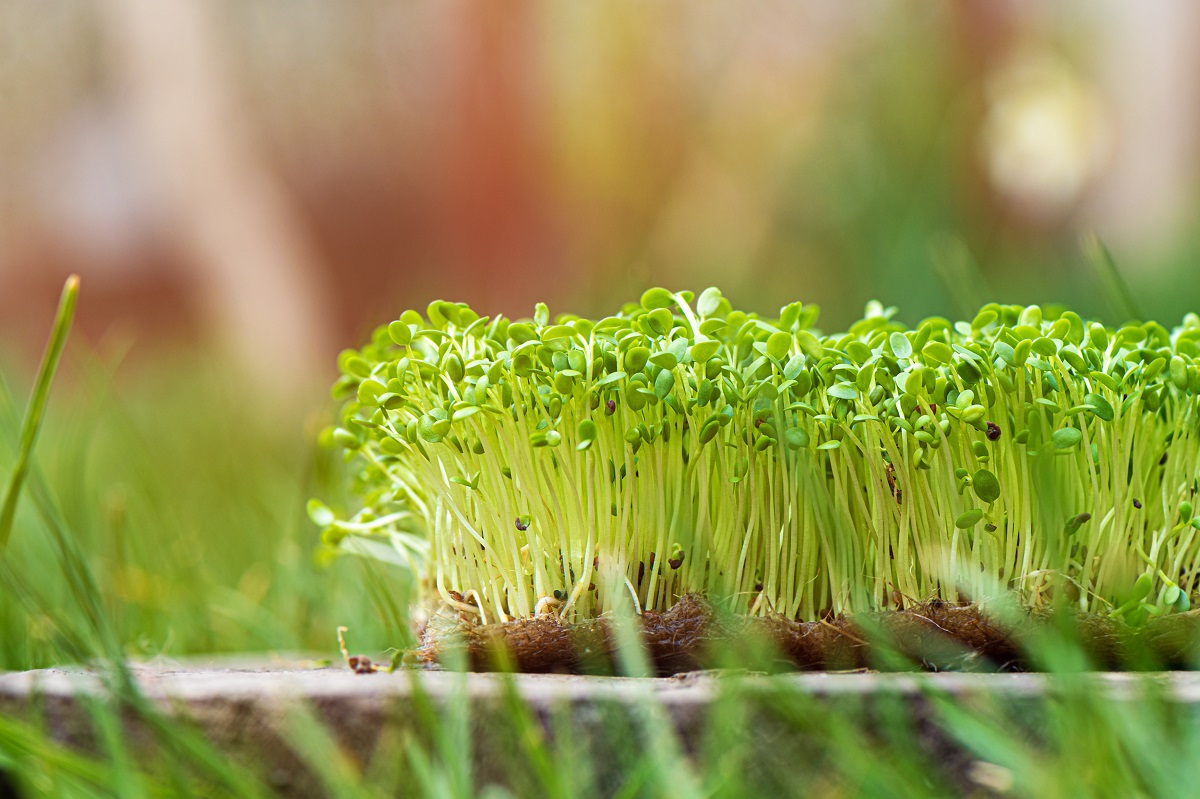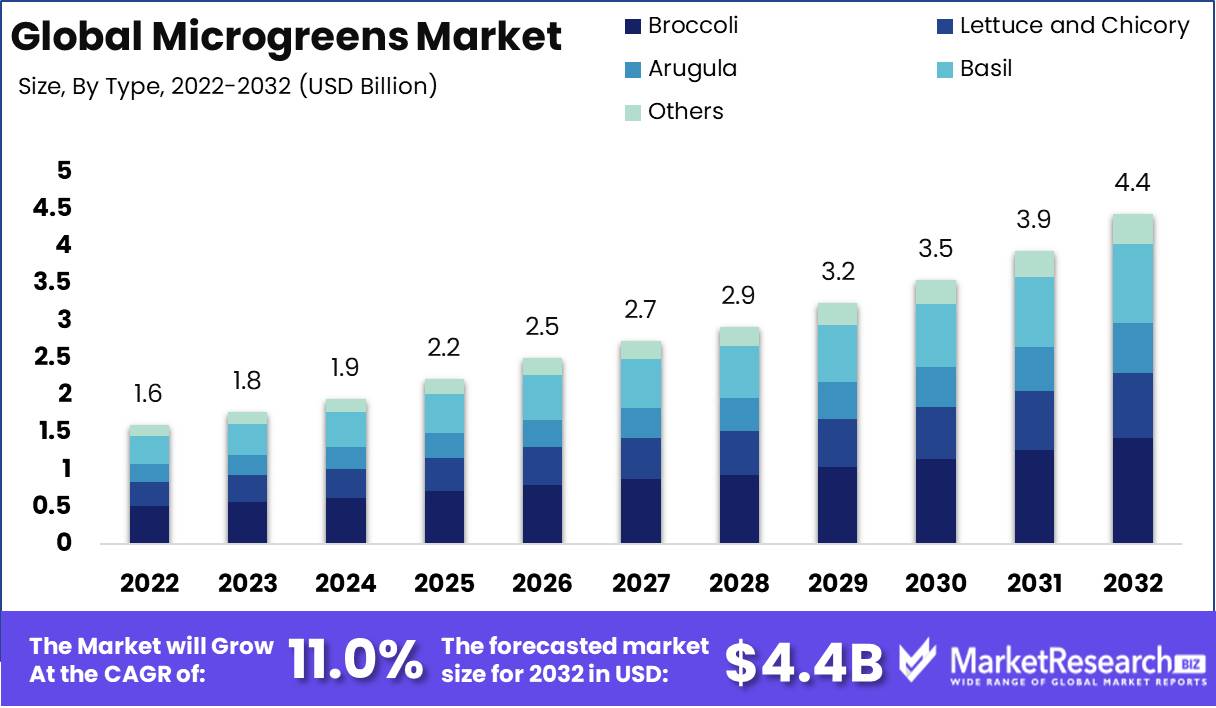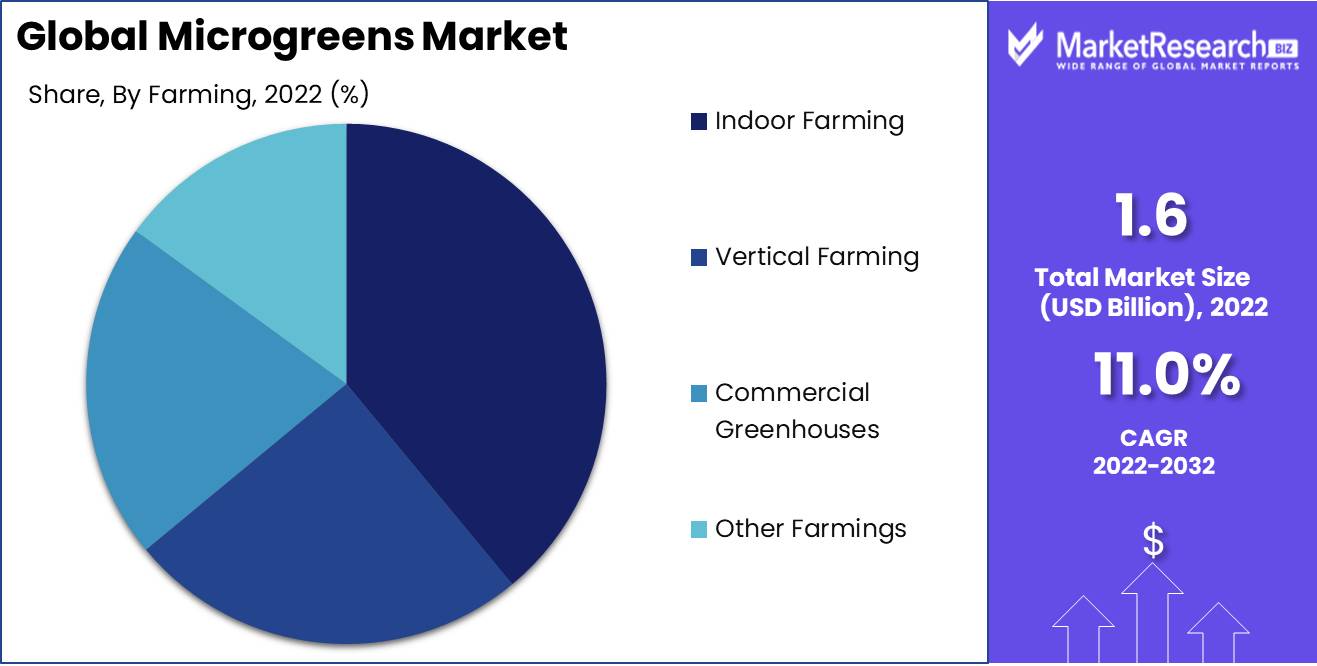
Microgreens Market By Type (Broccoli, Lettuce and Chicory, Other ), By Farming (Indoor Farming, Vertical Farming, Other), By Growth Medium (Peat Moss, Soil, Coconut Coir, Other), By Region And Companies - Industry Segment Outlook, Market Assessment, Competition Scenario, Trends, And Forecast 2023-2032
-
40277
-
July 2023
-
179
-
-
This report was compiled by Shreyas Rokade Shreyas Rokade is a seasoned Research Analyst with CMFE, bringing extensive expertise in market research and consulting, with a strong background in Chemical Engineering. Correspondence Team Lead-CMFE Linkedin | Detailed Market research Methodology Our methodology involves a mix of primary research, including interviews with leading mental health experts, and secondary research from reputable medical journals and databases. View Detailed Methodology Page
-
Quick Navigation
Microgreens Market size is expected to be worth around USD 4.4 Bn by 2032 from USD 1.6 Bn in 2022, growing at a CAGR of 11.0% during the forecast period from 2023 to 2032.
Microgreens, as their nomenclature suggests, are juvenile and delicate leafy greens that are typically harvested in the early stages of sprouting. Microgreens are the young, tender seedlings of various vegetables and herbs, providing concentrated flavors and vivid colors. They effectively cater to the increasing consumer desire for visually appealing, fresh, nutritious greens that offer essential nutrients. Consequently, microgreens serve as a convenient and delectable response to this emerging preference.

The market expansion and applications of microgreens extend beyond the culinary industries, encompassing various sectors such as cosmetics and skincare. These industries have recognized the numerous benefits of microgreens in promoting and preserving healthy skin. Microgreens possess antioxidant properties that can effectively safeguard the skin from the harmful effects of free radicals and environmental stressors. Consequently, they have gained significant popularity as key constituents in a diverse range of skincare products, including moisturizers, serums, and facial masks.
Several factors contribute to the growth and expansion of the microgreens market. To begin with, a significant factor driving the demand for nutrient-dense food sources is the increasing consumer awareness regarding the importance of a healthy diet. In addition, the rise in popularity of veganism and plant-based diets has led to a growing need for substitutes that can supply the necessary nutrients typically obtained from animal-derived products. Microgreens, due to their high content of plant-based proteins and other essential nutrients, serve as an ideal solution to fulfill this nutritional gap.
Microgreens have also found their place in the food industry, with many businesses incorporating them into their menus and fresh food product offerings. The demand for microgreens is not limited to traditional brick-and-mortar stores; it has also expanded into the world of eCommerce foods. Online retailers are now offering a wide range of microgreen products to cater to the digital-savvy consumers.
Microgreens businesses have become a profitable venture for numerous small and medium-sized entrepreneurs. Business owners are implementing various business models and strategies to meet the market demand. Concerns about market saturation have been raised, but the fastest-growing market segments are showing no signs of slowing down. The microgreens market is thriving due to key market trends, increased demand for fresh and nutritious food products, innovative business models, and efficient distribution methods. As consumers continue to seek healthy food options, the microgreens market is poised for sustained growth factors in forecast period.
Driving factors
Microgreens High in Nutrients a culinary fashion
In recent years, microgreen business have gained substantial popularity due to the rising demand for nutritious and flavorful foods among consumers. Early-harvested microgreens are rich in vitamins, minerals, and antioxidants. Not only do they lend a splash of color to any dish, but they also provide numerous health benefits. As consumers become more health-conscious, the consumption of microgreens has become an essential component of a well-balanced diet and levels of vitamins.
The microgreens market is currently experiencing significant key factors, driven by several key market drivers. One of the most prominent trends in the market is the increasing demand for fresh and nutritious food products. With a growing awareness of the importance of healthy eating, consumers are seeking out premium food products that offer high nutritional value. This has led to a surge in the popularity of microgreens, which are packed with essential vitamins and nutrients.
Microscopic Greens Tiny Health Boosters
The potential health benefits of microgreen business have sparked interest in these nutrient-dense greens. This has contributed to the expanding popularity of microgreens. Microgreens can contain up to 40 times as many vitamins and minerals as their mature counterparts, according to studies. They are especially abundant in the vitamins C, E, and K, as well as beta-carotene and lutein. In addition, microgreens are known to possess anti-inflammatory properties, promote cardiovascular health, and facilitate digestion. The popularity of microgreens among health-conscious individuals and culinary enthusiasts has been fueled by the growing awareness of these health benefits.
Microgreens Flourish in Urban Environments
The rise of urban cultivation and local food movements has also significantly contributed to the popularity of microgreens. Due to the lack of available space in urban areas, people have begun investigating alternative methods of growing fresh produce, and microgreens provide the ideal solution. These delicate greens can be grown in confined spaces or indoors, making them accessible to urban inhabitants.
The microgreens market is booming to key trends and drivers. Consumers' focus on health and nutrition has led to a surge in demand for these nutrient-packed greens, making them a rising star in the fresh food industry. Microgreens businesses are competing for the largest market share in this untapped market, although concerns about market saturation exist to increase marketing demand. To succeed, companies are closely monitoring market trends, adapting strategies, and technological innovation approaches.
Restraining Factors
Microgreens are perishable
The limited shelf life of microgreens is a challenge for producers in the microgreens market. These delicate greens have a small freshness window, making efficient supply chain management and delivery systems essential. To preserve quality and nutritional value, microgreens must be delivered fresh. Producers can invest in refrigeration systems during transit and storage and use novel packaging techniques to overcome this challenge. Using modified environment packaging can help increase the shelf life of microgreens, ensuring customers can enjoy them longer.
Scaling Production Issues
Scaling up production in the microgreens market is difficult due to limited space, equipment, and labor. As demand for microgreens grows, producers must innovate to meet this demand without sacrificing quality. The space limitations producers encounter may be addressed by vertical farming, hydroponics, and other cutting-edge cultivation methods. These strategies maximize microgreens' growing environment and vertical space usage.
Costly Production and Labor
Microgreens require precise attention to detail, making production labor-intensive. The necessity for specialized equipment and growing conditions raises production costs compared to conventional crops. These higher costs can be a challenge for producers entering the microgreens market or expanding. Producers should investigate novel financing methods and government grants for sustainable and urban farming to reduce these costs. LED lighting and smart watering systems can minimize overhead costs over time.
Poor Consumer Knowledge
Despite microgreens' portable business growing popularity, consumer knowledge and understanding of their advantages and culinary usage are still limited. Many potential consumers are unaware of the nutritional value and unusual flavors of microgreens, which has a lesser market size than more mainstream leafy greens. Producers must concentrate on education and promotion to overcome this challenge. Targeted marketing techniques, collaboration with chefs and nutritionists, and participation in farmers' markets and food festivals can boost awareness of microgreens and their diversity.
Competing Leafy Greens and Specialty Crops
The microgreens market confronts competition from other leafy greens and specialty crops with similar taste and nutritional value. Consumers can eat green veggies including spinach, kale, arugula, and watercress. Producers must highlight the distinctive properties of microgreens in order to stand out from the competition. Their powerful aromas, delicate textures, and vivid colors might draw health-conscious consumers, chefs, and culinary lovers.
Type Analysis
The broccoli segment is the dominant player in the microgreens market, which has shown tremendous growth in recent years. Microgreens are immature greens taken before the cotyledon leaves are fully grown. Health-conscious consumers love these greens for their nutritious content and unique taste.
The broccoli segment of the microgreens market has seen positive consumer trends and behavior. Consumers are actively searching for microgreens due to their health benefits. Due to their high vitamin A, C, K, and mineral content, broccoli microgreens are popular. Broccoli microgreens are adaptable because of their mild but distinct flavor.
Farming Analysis
The broccoli segment dominates the microgreens market, although the indoor farming segment is growing. Plants are grown indoors using hydroponics or vertical farming. The indoor farming segment dominates the microgreens market due to its advantages.
Like the broccoli segment, economic development in emerging economies drives the microgreens market adoption of the indoor farming segment. Sustainable, local food is in demand as these economies flourish. Indoor microgreen farming provides fresh produce year-round. Emerging economies looking to minimize imports and improve food security will appreciate this reliability.
The microgreens market's indoor farming segment has seen positive consumer behavior. Consumers are choosing locally grown, pesticide-free produce in response to growing concerns about food safety and environmental sustainability. Indoor farming provides pest-free, chemical-free settings. Indoor farming's shorter supply chain brings fresher produce to consumers, improving their experience.

Key Market Segments
By Type
- Broccoli
- Lettuce and Chicory
- Arugula
- Basil
- Other Types
By Farming
- Indoor Farming
- Vertical Farming
- Commercial Greenhouses
- Other Farmings
By Growth Medium
- Peat Moss
- Soil
- Coconut Coir
- Tissue Paper
- Other Growth Mediums
Growth Opportunity
Technology to Improve Production
Technological advances to improve production efficiency are a key growth opportunity for the microgreens market. Automated seed germination, irrigation, and harvest systems using smart sensors and data analytics can improve yields, quality, and production costs. Microgreen growers can meet demand and stay competitive in the market by using technology.
Product Variety
Consumers and new market segments need more microgreen varieties. Growers may satisfy a wide range of tastes and dietary requirements by continuously creating new microgreen varieties. Unique flavors, colors, and textures attract daring foodies and allow chefs and restaurants to collaborate. This focused approach raises brand awareness and attracts new customers in untapped markets.
The food industry is witnessing a transformation, driven by the demand for nutritious and functional foods, and microgreens are at the forefront of this shift. As consumers become more health-conscious, the microgreens market is poised for sustained growth, making it a lucrative space for businesses plan looking to capitalize on the intersection of nutrient-dense foods and wellness.
Market Growth
Beyond localized markets, the microgreens industry has huge worldwide untapped potential. Expanding into international markets offers exponential growth. Microgreens growers can cooperate with distributors and suppliers abroad to enter new markets by adjusting to local preferences and restrictions. Strategic alliances can enable cross-border cooperation with famous chefs and restaurants, increasing market exposure and adoption.
Microgreens are not only delicious but also an excellent source of essential vitamins. Their popularity as a nutritious food option continues to rise, making them a valuable addition to a healthy diet. The distribution of microgreens has also evolved, with a well-established distribution network and various distribution channels ensuring these nutritious greens reach consumers efficiently.
Latest Trends
Delicious Microgreens
One notable trend is the competition for the largest market share in the microgreen market. Microgreens' bright colors, powerful aromas, and high nutritional value have swept the culinary world. Chefs, home cooks, and health lovers love these cotyledon-stage plants. In recent years, the popularity of microgreens has risen, fueling their expansion in salad mixes and culinary garnishes.
Organic Microgreens Health Craze
As consumers become more health-conscious, organic and hydroponically farmed microgreens are in high demand. People like to eat microgreens as they get healthier. Miniature greens are grown without synthetic chemicals or pesticides, making them safe.
Smoothies with Microgreens
With the rise of health-conscious consumers, microgreens in smoothies and juicing have gained popularity. People are realizing the nutritional value of these little greens. Microgreens are rich in vitamins, minerals, and antioxidants, making them great for healthy drinks. Their intense flavors make smoothies delicious and nutritious.
The microgreens market is flourishing, fueled by several robust market drivers, especially in the realm of food. Microgreens are gaining immense popularity as nutrient-dense foods, offering an abundance of essential vitamins and minerals. This aligns perfectly with the broader trend of consumers seeking fresh and premium food products that contribute to a healthier lifestyle.
Microgreens Diversify Market
Value-added microgreens are another microgreens market trend. Businesses are exploring new ways to use these greens as their popularity rises potential opportunities. Microgreens are now in salads, sandwiches, snacks, dips, spreads, and beauty products. This diversification has given microgreens a new market.
In today's digital age, microgreens business have also found their place in the world of eCommerce foods, with online retailers and online stores offering a wide array of microgreen products. This shift reflects the evolution of the food industry, with functional foods like microgreens playing a pivotal role in meeting the changing dietary preferences of consumers.
Fresh Convenience
Microgreen subscription services have arisen as a simple and affordable alternative for consumers to enjoy these nutritional powerhouses of profitable business. Subscribers receive fresh microgreens from these services and production. The rise of subscription services has boosted the microgreens market and made these tiny greens available.
Regional Analysis
North America region dominates the microgreens market due to growing demand. Local markets and worldwide cuisine demand microgreens. North America supplies fresh, healthy microgreens to consumers worldwide through its efficient distribution networks and supply chains.
Microgreens are a new trend that is quickly growing in popularity in the ever-changing world of agriculture. Health-conscious consumers and imaginative chefs love these small, nutrient-packed greens. Microgreens have become a big role in the culinary world due to their brilliant colors, powerful flavors, and multiple health advantages. The North American region dominates the microgreens market.
North America tops microgreens production. The region's climate, agriculture, and technology have created the optimal environment for growing microgreens. tThe region forecast emphasizes sustainable farming, which boosts microgreens growth opportunities.
North American region has a thriving culinary industry that uses microgreens. Chefs are always experimenting with microgreens to make delicious and beautiful dishes. Their use in gourmet dining, trendy eateries, and even home kitchens has increased market demand for microgreens.
Strong support systems and infrastructure for growers contribute to the North American region's supremacy in the microgreens market. Numerous agricultural research facilities, universities, and extension agencies in North America provide microgreens farmers with significant resources and knowledge.

Key Regions and Countries
North America
- US
- Canada
- Mexico
Western Europe
- Germany
- France
- The UK
- Spain
- Italy
- Portugal
- Ireland
- Austria
- Switzerland
- Benelux
- Nordic
- Rest of Western Europe
Eastern Europe
- Russia
- Poland
- The Czech Republic
- Greece
- Rest of Eastern Europe
APAC
- China
- Japan
- South Korea
- India
- Australia & New Zealand
- Indonesia
- Malaysia
- Philippines
- Singapore
- Thailand
- Vietnam
- Rest of APAC
Latin America
- Brazil
- Colombia
- Chile
- Argentina
- Costa Rica
- Rest of Latin America
Middle East & Africa
- Algeria
- Egypt
- Israel
- Kuwait
- Nigeria
- Saudi Arabia
- South Africa
- Turkey
- United Arab Emirates
- Rest of MEA
Key Players Analysis
In the microgreens market, DUMMEN ORANGE, a global horticulture company, is a major player. DUMMEN ORANGE has introduced a wide selection of microgreen cultivars to meet consumer expectations with a focus on continuous innovation and quality. They lead the industry with their commitment to sustainability and cutting-edge technology. DUMMEN ORANGE shapes microgreens by exceeding client expectations.
Swiss-based agricultural business Syngenta leads microgreens market research and development. Syngenta has consistently improved microgreens' taste and texture by investing in unique breeding procedures. They help microgreen growers by addressing their issues by competitive analysis.
The Beekenkamp Group is based in the Netherlands and is renowned for its expertise in growing high-quality microgreens. Beekenkamp Group is known for its excellent microgreens and sustainable production practices. They ensure their microgreens exceed the highest standards and give an exceptional gastronomic experience by keeping stringent quality control throughout the production process.
The Netherlands-based Hofland Flowering Plants cultivates nature's bounty and offers a wide choice of microgreens. They provide chefs, wholesalers, and consumers with a wide range of microgreens using their seed selection and cultivation expertise. Hofland Flowering Plants still drives microgreens market growth.
SAKATA, a leading player in the microgreens market, is renowned for its commitment to creative solutions for growers. SAKATA has developed cutting-edge microgreen cultivation technology. SAKATA has become a leading industry player by giving growers the tools they need to flourish.
DUTCH FLOWER GROUP, based in the Netherlands, is a key player in the microgreens market and excels at meeting the expanding demand. Dutch Flower Group offers a consistent supply of high-quality microgreens to retailers and distributors worldwide through its broad network of growers and suppliers. Their commitment to sustainability and consumer satisfaction boosts their market power.
Top Key Players in Microgreens Market
- DUMMEN ORANGE (U.S)
- Syngenta (Switzerland)
- Beekenkamp Group (Netherlands)
- Hofland flowering plants (Netherlands)
- SAKATA (U.S)
- DUTCH FLOWER GROUP (Netherlands)
- MARGINPAR BV (Netherlands)
- Walter Blom Plants BV (Netherlands)
- Selecta Klemm (Germany)
- Double H Nurseries Ltd, (U.K)
- ARCANGELI GIOVANNI (Italy)
- KP Holland (Netherlands)
- Ball Horticultural Company (U.S)
Recent Development
- In 2023, Oasis Microgreens, a leading microgreens company, reported a significant milestone for the microgreens industry: a successful $10 million Series A fundraising round.
- In 2022, Farmbox Foods, a leading microgreens manufacturer, increased production by 50% 2022 to satisfy consumer demand for these nutritious greens.
- In 2021, Leading vertical farming startup Plenty made waves 2021 with its new microgreens line.
- In 2020, Bowery Farming, a major vertical farming business, made an important statement.
Report Scope:
Report Features Description Market Value (2022) USD 1.6 Bn Forecast Revenue (2032) USD 4.4 Bn CAGR (2023-2032) 11.0% Base Year for Estimation 2022 Historic Period 2016-2022 Forecast Period 2023-2032 Report Coverage Revenue Forecast, Market Dynamics, COVID-19 Impact, Competitive Landscape, Recent Developments Segments Covered By Type (Broccoli, Lettuce and Chicory, Arugula, Basil, Other Types), By Farming (Indoor Farming, Vertical Farming, Commercial Greenhouses, Other Farmings), By Growth Medium (Peat Moss, Soil, Coconut Coir, Tissue Paper, Other Growth Mediums) Regional Analysis North America – The US, Canada, & Mexico; Western Europe – Germany, France, The UK, Spain, Italy, Portugal, Ireland, Austria, Switzerland, Benelux, Nordic, & Rest of Western Europe; Eastern Europe – Russia, Poland, The Czech Republic, Greece, & Rest of Eastern Europe; APAC – China, Japan, South Korea, India, Australia & New Zealand, Indonesia, Malaysia, Philippines, Singapore, Thailand, Vietnam, & Rest of APAC; Latin America – Brazil, Colombia, Chile, Argentina, Costa Rica, & Rest of Latin America; Middle East & Africa – Algeria, Egypt, Israel, Kuwait, Nigeria, Saudi Arabia, South Africa, Turkey, United Arab Emirates, & Rest of MEA Competitive Landscape DUMMEN ORANGE (U.S), Syngenta (Switzerland), Beekenkamp Group (Netherlands), Hofland flowering plants (Netherlands), SAKATA (U.S), DUTCH FLOWER GROUP (Netherlands), MARGINPAR BV (Netherlands), Walter Blom Plants BV (Netherlands), Selecta Klemm (Germany), Double H Nurseries Ltd, (U.K), ARCANGELI GIOVANNI (Italy), KP Holland (Netherlands), Ball Horticultural Company (U.S) Customization Scope Customization for segments, region/country-level will be provided. Moreover, additional customization can be done based on the requirements. Purchase Options We have three licenses to opt for: Single User License, Multi-User License (Up to 5 Users), Corporate Use License (Unlimited User and Printable PDF) -
-
- DUMMEN ORANGE (U.S)
- Syngenta (Switzerland)
- Beekenkamp Group (Netherlands)
- Hofland flowering plants (Netherlands)
- SAKATA (U.S)
- DUTCH FLOWER GROUP (Netherlands)
- MARGINPAR BV (Netherlands)
- Walter Blom Plants BV (Netherlands)
- Selecta Klemm (Germany)
- Double H Nurseries Ltd, (U.K)
- ARCANGELI GIOVANNI (Italy)
- KP Holland (Netherlands)
- Ball Horticultural Company (U.S)




